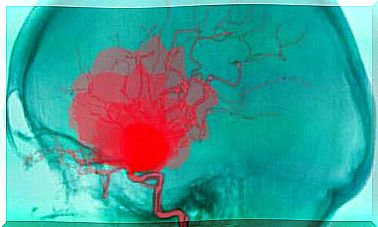Bone Metastases: Symptoms And Treatments

Bone metastases arise in certain cases during the progression of certain types of cancer. Ultimately, this will be a serious complication affecting the bones. It is caused by neoplastic cells from a tumor in the body moving to a bone.
We must emphasize that bone metastases are not the same as the presence of primary bone cancer. In other words, the disease did not originate in the bone tissue, but in another organ, such as the chest or lungs.
We can say that metastases can arise in all bones. However, they are more often registered in the spine and in long bones. This has to do with the way in which both the blood and lymphatic circulation drain fluids from the body.
Once a neoplastic cell of a different origin has arrived in a bone, it begins to multiply. Bone metastases usually produce substances that stimulate bone tissue cells: osteoblasts and osteoclasts. However, this stimulation is excessive and the tissue suffers as a result.
Around the bone metastases, the bone tissue can weaken due to the action of osteoclasts, or harden due to the excessive action of osteoblasts. Both processes are very harmful.
Most cancers can metastasize, but it is more common in breast and prostate cancers. Once it happens, patients have symptoms caused by the primary tumor as well as the new tumor that has arisen.
Symptoms of bone metastases

Bone metastases have common symptoms beyond the different primary tumor that causes them. Some of the most common symptoms include:
Pain
This is the main feature. However, it can be intermittent or persistent pain. In some patients, the pain may worsen with movement. In others, the pain is always present, even during rest. This can make the treatment of this complaint very difficult.
Fractions
As we mentioned, metastases can weaken the bone. A weak bone breaks faster, sometimes even with minimal load. It is important that patients with bone metastases be very careful to avoid fractures.
Hypercalcemia
The damage to the bone tissue caused by the metastasis promotes the release of calcium into the blood. As this release increases, more complaints arise. For example, patients experience constipation, lack of appetite, and polyuria (frequent urination). Due to the combination of lack of appetite and frequent urination, the patient can become dehydrated.
Compressions
One of the most common places to find bone metastases is in the spine. Damaged vertebrae can shrink, collapse and change position. Then the nerves or spinal cord can become pinched.
Treatments for bone metastases
There are two ways to approach the treatment of bone metastases. One form is a local approach, the other a systemic approach to the problem.
The choice depends, among other things, on the primary cancer, the clinical condition of the patient and the availability of the treatment. Let’s take a closer look at the options.
Systemic treatment options
- Chemotherapy: This is the use of drugs that interrupt certain processes of the tumor cells. It is generally the most commonly used option for bone metastases.
- Radiotherapy: By exposing the body to radiation emitted by special equipment, the cancer cells are destroyed. The number of sessions and dose of radiation therapy varies from patient to patient. Usually it is very effective in combating the pain caused by bone metastases.
- Hormone therapy: This involves the use of drugs that block certain hormones. It is a therapy that is common in breast and prostate cancer.
- Immunotherapy: This treatment also involves the use of drugs. However, these mimic the functions of the immune system.
- Radiopharmaceuticals: In this case, radiation is emitted from inside the body and not from outside equipment. Radiopharmaceuticals are first injected into the patient’s body. They go through the blood to the bone metastases and then attack the tumor cells there.
Additional and Local Options
- Biphosphonates: Biphosphonates block the action of osteoclasts to prevent them from further attacking and then destroying healthy bone tissue.
- Denosumab: Like bisphosphonates, denosumab also blocks the action of osteoclasts. It works a little differently than bifophonates, but it produces a similar end result.
- Vertebroplasty: When bone metastases are in the spine, there is the option of administering a direct injection of fast-acting bone glue. This is called a vertebroplasty. The effectiveness of this procedure is quite good for relieving pain.
- Surgery: Finally, surgical treatment is available if the patient meets certain conditions. If the metastasis is accessible from the outside, a surgeon may opt to operate and remove (as much of) the tumor as possible.
Conclusion on bone metastases
The development of bone metastases is a serious complication of cancer. It is important that the patient has, in addition to sufficient support from his family, a team of experienced doctors who can provide him with the best options available.
With the new available therapeutic options, it is possible to significantly improve the quality of life of people suffering from this disease.









